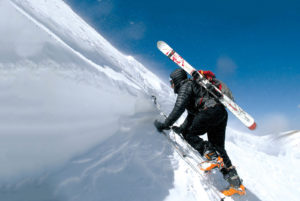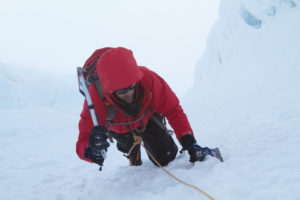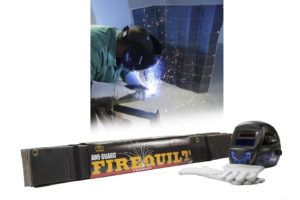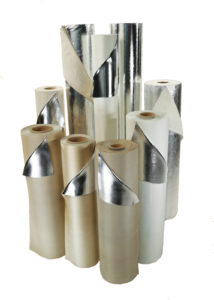
New textiles and applications that control temperature provide comfort and safety in extreme conditions.
When obstacles for achieving a goal are temperature related, there’s a good chance that textiles are a part of the solution.
Just ask Erik Weihenmayer, who has scaled the Seven Summits (the highest mountains on each of the seven continents) and used high-performance textiles to keep him warm in his endeavors. Weihenmayer—who became the first blind climber in history to reach the summit of Mount Everest—has firsthand information about how performance gear … well … performs. And that is something that manufacturers need to know. From what covers mountain climbers from head to toe to what lines the tents of warfighters, thermal textiles bring survival. Blind or seeing, there’s an element of faith that the users of thermal products invest, and that’s exactly what drives manufacturers to achieve
the highest levels of performance.
Extreme sportswear
Weihenmayer’s most recent conquest was Mount Huntington Peak in the Alaska Range in June 2015. On this, his fourth try, it took him 50 hours to reach the summit of more than 12,000 feet, a vertical challenge of snow and ice. For the successful attempt, Weihenmayer and his team used products made from Q.Shield™ from Mountain Hardwear, Richmond, Calif., for sleeping gear, made from water-shedding nanoparticles that are fused into the shell’s fibers. “We bivvied on an ice ledge in our down bags,” Weihenmayer says. “In environments like Alaska that are cold and humid, Q.Shield enables you to use down, which is warmer, lighter and more compressible than synthetics.”

Much has changed in regard to equipment over the last 10 years. Materials are lighter weight, as well as stronger. “Technology gives you an edge,” Weihenmayer says. “Every ounce adds up. Now it’s night and day between what we packed in the past. Every ounce saved gives you a bit more energy to feel better and go faster.” (When he climbed Everest in 2001 his boots weighed about four pounds each. Now the boots he uses weigh less than two pounds each.)
“Your gear is so important,” Weihenmayer says. “One bit of skin exposed for 30 seconds will turn white and have frostbite. The right gear is like a cocoon that is keeping you alive. We depend on those high-tech cocoons.”
Heat storage
Among thermal control products revolutionizing textiles are phase change materials (PCMs)—a type of latent heat storage capable of storing and releasing heat as needed. Schoeller Technologies, a division of Schoeller Textil AG based in Switzerland, launched its newest thermal control product, solar+TM, in 2012. The product is a heat absorption treatment that can be applied to almost any textile. “This is something that is really brand new,” says Hans Kohn, COO of Schoeller Technologies.
The first adopter of the technology was Kjus, a Swiss high-end skiwear brand that used the product in a downhill skiing suit. Designed exclusively for cold weather products, it will make the garment three to five degrees warmer than it would be otherwise. “Just enough difference so that you might feel comfortable when you normally might feel freezing,” he says.
The second project is a very thin golf jacket. “A bulky jacket inhibits your game when you play golf in cold weather,” Kohn says.
Not so extreme, but possibly more attractive to the less adventurous masses, are applications for upholstery and outdoor furniture. “The product is already being used in blankets for outdoor restaurants,” Kohn says.
The company’s PCMs are, in fact, found in many applications, including medical products, but its core business, Kohn says, is materials for functional fashion and sports.
However, thermal control functions in garments are becoming more important in industrial settings. High-end fashion may be an earlier adopter because it “loves new things,” he says, but workwear is following suit and getting more sophisticated too. “We believe solar+ is growing and thermal regulation will be moving to applications you normally wouldn’t expect,” Kohn says.

Through thick and thin
Cold temperatures can be one threat; extreme heat is another. Just ask any firefighter. Kathie Leonard, president of Auburn Manufacturing Inc., Mechanic Falls, Maine, defines extreme as anything more than 500 degrees Fahrenheit.
“We started this company to replace asbestos textiles using Nomex® and Kevlar®, not in strength-related applications, but as thermal barriers,” Leonard says. “For us it was more about the insulation value and making the right thickness. Protecting in environments where extreme heat is critical, that’s
what we do.”
The company’s story is one of adaptation and growth, incorporating new materials and combinations of them to create more protection. It moved to FiberglasTM yarns because they not only take a higher temperature, Leonard says, but they are virtually noncombustible. Eventually, the company incorporated fiberglass and aramid hybrids to produce proximity suits for workers who needed to be close to forges or large ovens. Auburn also produces amorphous silica [fiberglass without impurities] textiles to provide heat resistance to 3,000 degrees F.
“Now you’re in a very fringe market,” she says, which includes military uses, ship repair, power generation and especially nuclear power, oil refining, foundries and forges, and mining operations.
Putting it together
Six years ago, Auburn patented its first composite, a modularized insulation, designed for institutions and industrial or commercial buildings. By combining components, the composite named Ever Green® Cut’nWrapTM creates a flexible barrier using CAD-driven quilting equipment, which allows products to be customized.
“Nobody had ever done it,“ she says. “Most institutions are way under insulated in their mechanical systems. That’s where you can lose as much as 85 percent of your heat.”
Furthermore, the usual practice of making insulating products by hand was inefficient and costly so that most facilities are not optimally insulated.
“Everything was a one-off,” she says. “We see covers that are made by hand and they may be overkill. Industrial spaces might need a different level of insulation than an institution. In these spaces, 1 inch of insulation cuts down 90 percent of heat loss. At 2 inches you only gain another 5 percent.”
The company decided to approach sustainability managers, facility managers and engineers to promote the new concept and met with moderate success, but Leonard says they’ve worked hard to educate the market and are now making “very good progress.”

Tents for the troops
Producing military tents that control temperatures is also on the mind of many manufacturers. Not only is temperature control at the top of the list, but delivering comfort at decreased fuel consumption is also of paramount importance.
“Everybody is looking at having thin, lightweight, packagabilty goals,” says Joe Fields, vice president of business development for Outdoor Venture Corp. (OVC), Stearns, Ky. “All of the Services—Army, Marines, etc.—are doing a self-imposed reduction in fuel use. They’re all setting a 25- to 30-percent improvement over usage of current insulated products.”
Two types of tent insulation liners commonly used include a radiant-type insulation, which is similar to a bubble wrap that is aluminized on one side and typically white on the other; and a batting-type insulation, but military tent manufacturers continue to explore new textiles and systems.
One recent development by OVC is its Collapsible Insulated Double Bump door. The insulation is pliable and the skins of the door are made of the same material as the tent so all of the attributes of the tent body also exist in the door.
“We developed these doors to solve a problem for our clients,” Fields says. “The Army had come out with a solicitation of a standard double bump door—a hard-walled door that was honeycombed. They typically got damaged during shipment. So we developed this insulated double bump door system that not only eliminated the problems they were having with the old doors, they also can be folded up and packed with the standard packaging, plus provide insulation that is equal to or better than the honeycombed door system.”
Also in response to customer need, OVC developed the insulated relocatable tent pad system, currently being tested at Fort Devens Army base in Devens, Mass. The system replaces wooden plywood tent pads that soldiers would typically destroy after they were finished using them.
“The system provides users with approximately an R value of 13 on the floor, and it doesn’t require any specific tools to put together,” Fields says. “Soldiers can set it up and tear it down in about 90 minutes. It’s a real time saver and provides insulation under the body of the tent.”
Two of OVC’s liner systems are currently in testing with the Army. One system, which needs further testing in the lab, involves a process that could be put into the outside skin, eliminating the liner entirely. The other is in the prototype stage; it is a one-ply material, and would have an R value in the range of 6 or 7. “Both of these should meet the goal of 30 percent reduction, at least on a system level,” Fields says.
From extreme sports to industrial protection to troop support, researchers are continually developing new thermal control textiles and applications. It’s a segment of the industry where needs continue to drive innovations.
Sigrid Tornquist is a freelance writer and editor based in St. Paul, Minn. Turn to page 86 for contact information on sources used in this article.
Schoeller Technologies believes that its new heat absorption treatment, solar+TM, could be used with almost any textile in a variety of applications, including upholstery for outdoor furniture. Its first adoptor was Kjus, a Swiss skiwear brand, using it in downhill skiwear. Photos: Schoeller Technologies.
Test methods for tent liners
There is currently no industry standard for testing tent liners or tent systems, and because of that it’s difficult to substantiate claims made about the effectiveness of insulation products.
“The industry might want to work together on developing test method standards,” says Joe Fields, vice president of business development for Outdoor Venture Corp., Stearns, Ky. “It’s the only way to have a true understanding of what one liner system will do over another, and I think people involved in manufacturing insulation products would welcome it.”

 TEXTILES.ORG
TEXTILES.ORG





One response to “Not too hot, not too cold”